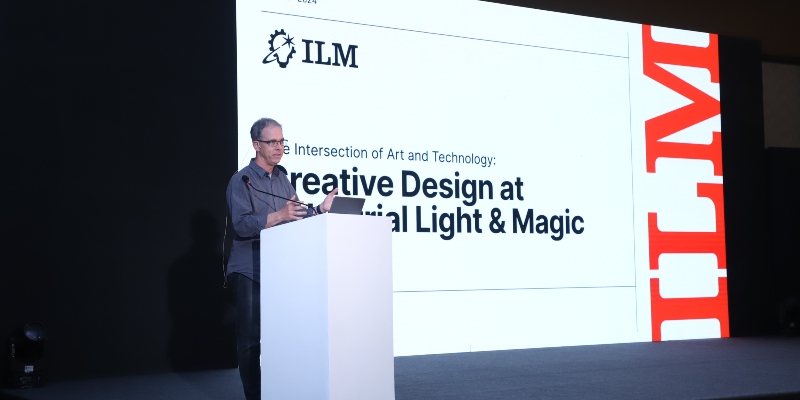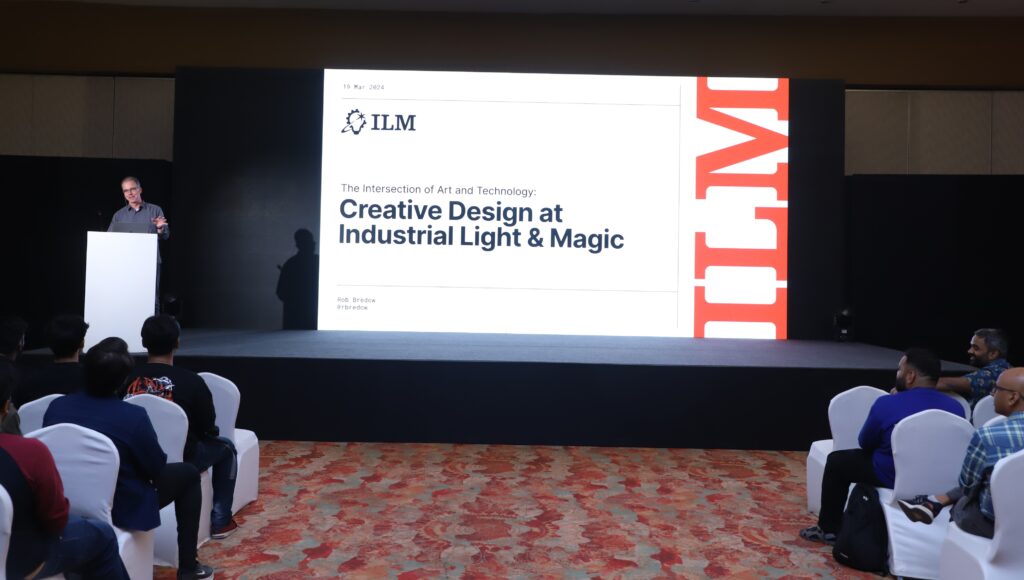VFX-giant ILM’s (Industrial Light & Magic) Rob Bredow conducted a masterclass on the topic “The Intersection of Art and Technology: Creative Design at ILM” in India on 19 March 2024.
The masterclass, which was earlier presented at Siggraph Asia 2023, was organised at Nesco Grounds in the city of Mumbai. Bredow, who is senior vice president, creative innovation and chief creative officer at ILM, spoke about how design can help drive creative opportunities and illustrate how different themes bring life to one’s creative work. Having worked on various films like Independence Day, Godzilla, Stuart Little and Solo: A Star Wars Story, Bredow comes with extensive experience in the field of visual effects.
So how does one start thinking about creative design and the process behind it? Bredow has broken it down into three steps:
- Just start: “It’s about getting started, taking risks and diving into a creative role even if you don’t have it all figured out up front,” Bredow said.
- Defining the theme: The theme is what keeps a team engaged throughout a project, expanding its creative opportunity. By defining a clear theme and committing to it, ordinary ideas can be turned into extraordinary ones.
- Lean into the constraints: Artists have to make the best use of resources in a stipulated time while keeping their creativity intact. Bredow shared that one needs to view these constraints as opportunities rather than limitations, as it can help individuals uncover innovative solutions and push the boundaries of creative expression.
Just start
To start, means to take inspiration and build on it, explained Bredow. “When searching for inspiration, it’s amazing to see what people can create.”
To explain how inspiration can lead to creativity, Bredow shared the example of Norman Rockwell’s painting of Rosie the Riveter, which was inspired from Michelangelo’s painting of the prophet Isaiah from the Sistine Chapel.
In another interesting example, Bredow illustrated how the creators of Disney Animal Kingdom creatively tackled a challenge. The then Disney CEO asked them to construct a roller coaster within their “nature-based” theme park. They navigated this task by developing the now immensely popular ride, Expedition Everest – Legend of the Forbidden Mountain, which they seamlessly integrated into their nature-themed setting.
“Regardless of your role, creative problem-solving is essential,” emphasised Bredow.
To create something, firstly, an artist needs to have done the background work and understand the work done by legends who came before them, he said. Secondly, “creative endeavours are often built upon existing works,” he said. “In our daily work, we frequently draw inspiration from our favourite scenes in movies and series.” He shared how Star Wars franchise creator George Lucas openly acknowledges that he has taken multiple references from the work of Japanese filmmaker Akira Kurosawa.
Defining the theme
“Defining a theme and working underneath that expands your creative opportunities and sets your whole team free,” Bredow said.
Soon after he joined ILM, Bredow was asked to take on the role of visual effects supervisor for Solo: A Star Wars Story. “You can imagine how it was an awesome opportunity, but at the same time a little bit intimidating. You don’t want to be the person who messes up the visual effects in a Star Wars movie, right,” said Bredow, who then went on to win an Academy Award for his work on the film. He explained how his team established a theme for Solo and creatively overcame hurdles during the film’s shoot.
Bredow also shared how his team at ILM designed StageCraft – a virtual production technology consisting of a video wall, utilised specifically for VFX-heavy projects.
Lean into the constraints
“There’s a schedule, there’s a budget, there’s a release date, and we have to work within those constraints and get the movie on the screen. So as creators, how do we focus our limited resources on the most important things,” Bredow asked the room full of audience that was listening with rapt attention. Quoting a filmmaker, he said that it’s not about making a shot perfect, it’s about telling the story.
Giving examples from the VFX tables of various films, Bredow explained that when supervisors are on time constraints, they have ignored polishing certain imperfect shots if those shots do not affect the storytelling in any manner. So if there is an imperfection that you can live with, you should focus your efforts on the things that matter more when you are on a tight schedule, Bredow advised the artists in the room.
Bredow asked artists to never forget the important difference between being a filmmaker and being a shot maker. “Approach your work with the bigger picture in mind. Watching your work in the context of the story changes your creative output and allows you to utilise your limited resources where they matter the most.”
Overall, Bredow’s masterclass offered invaluable insights into the creative process, emphasising the importance of drawing inspiration from existing works, defining thematic focus, and embracing constraints. Attendees left with a renewed understanding of how to navigate the complexities of creative design in the visual effects industry.


